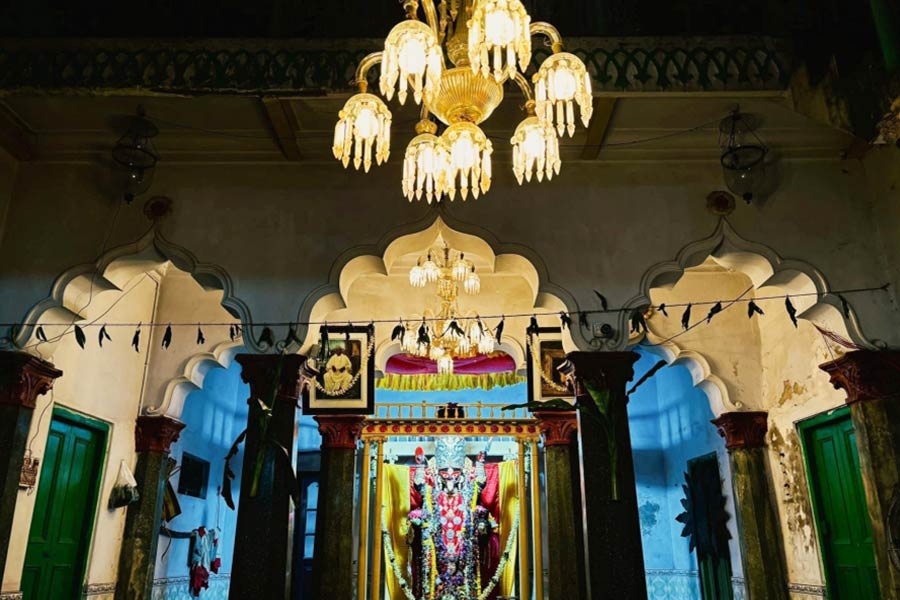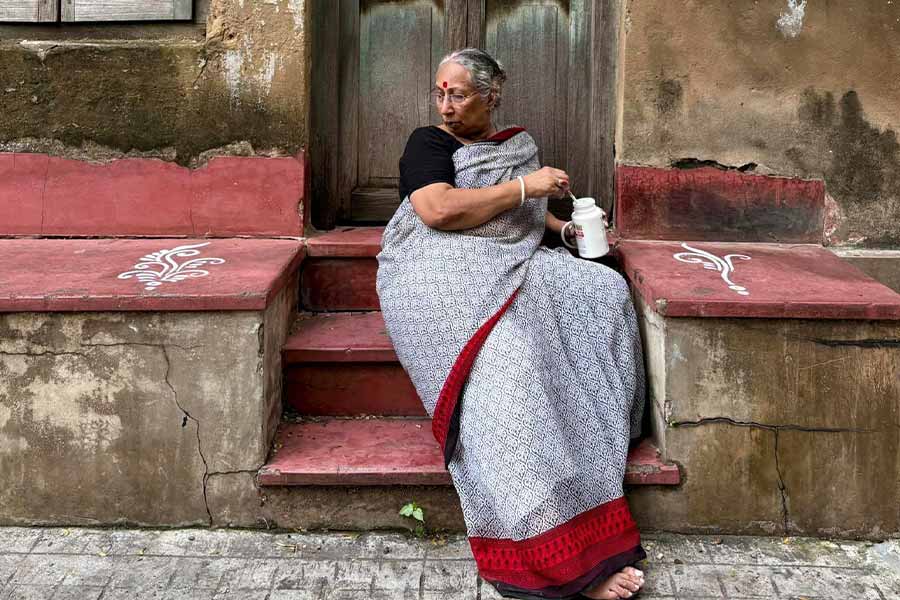At Bowbazar Haldar Bari, the highlights of their Kali Puja are their overall lighting of the house. The lighting of several earthen lamps and candles along with two glass lamps (locally known as ‘phanush’) can overcome the aura of even some of the glamorous Sandhi Pujas of several traditional houses of Kolkata.
The Haldar family originated from Badlapur village located around 13km northeast of Boinchi under Purba Bardhaman district. Lakshmi Narayan Haldar of this family was the first descendant of the family who came to Kolkata somewhere around the middle of the 18th century. He was a landlord and had considerable property in his name. He and his descendants dabbled in several types of businesses in Kolkata.
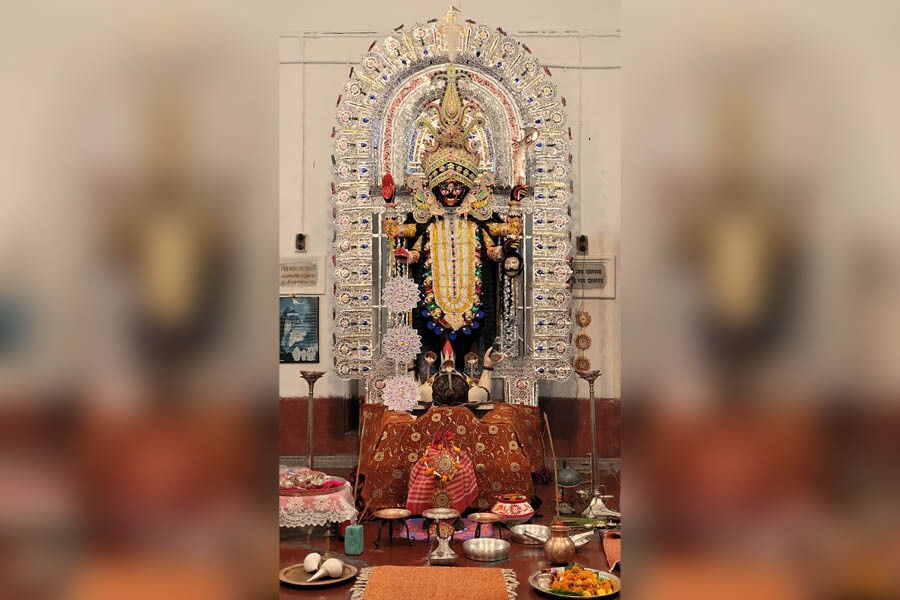
Goddess Kali of Bowbazar Haldar Bari has a decorative ‘chalchitra’ with a seven-kalka crown Bowbazar Haldar Family
The puja started around 1750 in the present residence of the Haldar family at 15 Ramnath Kabiraj Lane in Bowbazar area. The Haldar family also celebrates Durga Puja on the same premises from 1847 with a permanent idol of goddess Singhabahini made of astadahatu (alloy of eight metals). The deity was established by Rasmani Dasi, he wife of Ram Narayan Haldar, the younger brother of Lakshmi Narayan.
Kali Puja is conducted on the single-arched Durga dalan studded with some small stained-glass windows. Durga Puja is conducted in the same thakur dalan. The courtyard in front of the thakur dalan is long rectangular one surrounded by balconies on the first floor. The walls of the courtyard are decorated with large age-old paintings of dasmahavidyas.
The present-generation descendant of the family, Barun Kumar Haldar, narrated to me how his great-grandfather Kali Das Haldar had been into money-lending business. Barun’s grandfather, Rakhal Das Haldar, was involved in hardware business, manufacture of tea garden-related items (like packing materials) and providing several services to these properties, shipping-related repairs and maintenance and had a tools and equipment factory at Liluah, Howrah district. Rakhaldas Halder was also was the distributor-cum-agent of Sheffield Steel owned by John Yeats. Rakhaldas was a member of the Calcutta Club and Bengal Club at that time. His was among one of the first 50 subscribers of landlines in Calcutta in 1942.
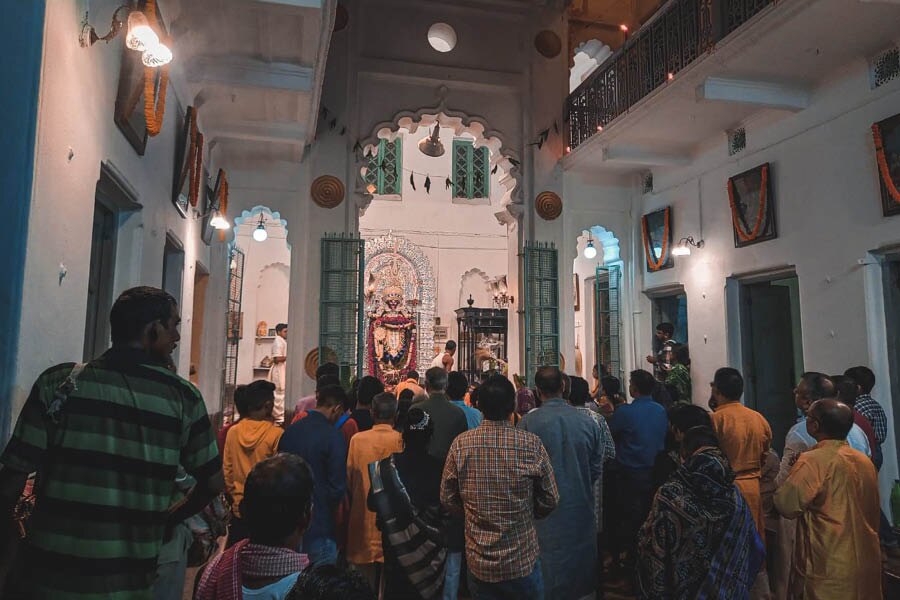
Devotees and family members gather in the courtyard of the Bowbazar Haldar Bari Bowbazar Haldar Family
Unlike many traditional houses in modern days whose idols are constructed at a potter’s studio, the deity is made in the thakur dalan of the Haldar family. The kathamo or framework of the goddess is constructed between pratipod (the day after Mahalaya) and Chaturthi. After the kathamo is ready, it is worshipped on Ashtami of Durga Puja. The construction of the idol starts from the day of Lakshmi Puja.
A bedi or platform is made of fresh clay on the thakur dalan. This is done on the day of first Ekadoshi before Kali Puja (this year, it was the day before Dhanteras). Seeds of paanch korai (five pulses) and pancha soshya (five types of foodgrains) along with cow dung water are spread on this platform. The platform remains for eight days. It is constructed below the wooden chowki (elevated platform) on which the deity is instated.
The artisan who creates the clay idol comes from Kumartuli but the daaker saaj is done by artisans from Krishnanagar. Apart from her décor, an extremely decorative chalchitra (backdrop of the deity) adorns the presence of the goddess. The chalchitra is only made of decorative elements typical of a daaker saaj which consists of rangta (silver foil), silver sequins and reels of metallic wires known as bulen.
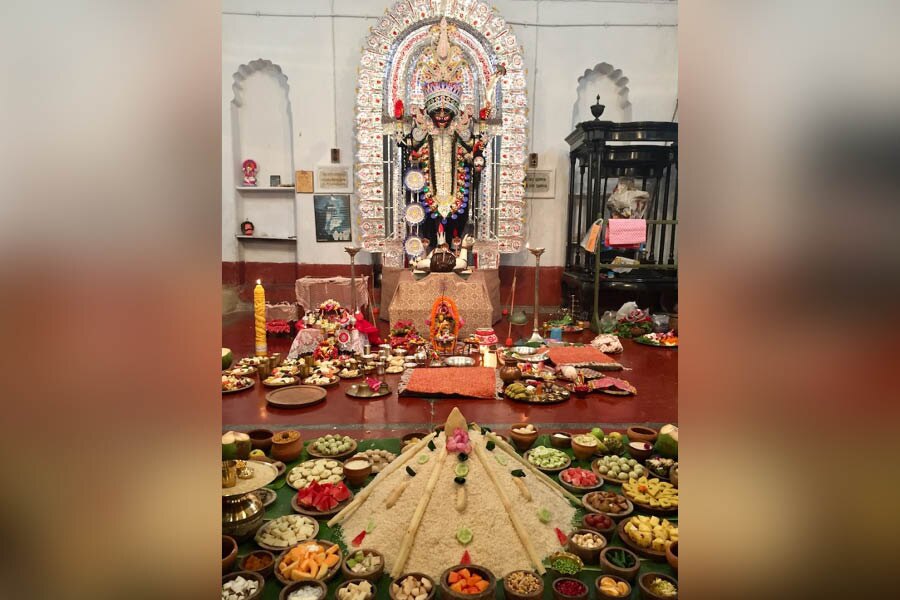
‘Naibedya’ (food offering) in front of the goddess of Bowbazar Haldar Bari during Kali Puja Kinjal Bose
Barun Kumar Haldar said that this type of chalchitra is known as Berh Chakra Chota. Barun also pointed out that the goddess is adorned with a seven-kalka (a decorative motif) crown, a design which can be created only by specific artists. An adhesive was formed using Biroja – an extract of a tree with bee wax to fix the element of daaker saaj to its base. The total décor is fixed to the body of the deity used adhesive made out of maida mixed with copper sulphate.
Apart from the daaker saaj, the goddess is adorned with nose ring, bangles, taira and tikli made of gold. The tongue of the goddess is made of gold. She wears a silver mol (anklet bells) and a silver garland of skulls around her neck. Mahadev (Shiva) lying below her is adorned with three snakes, dugdugi (a musical instrument), shinge and a kolke for taking a smoke, all made of silver.
During Kali Puja, the ghot is first established after Amavasya sets in. Then the idol of Alakshmi, goddess of misfortune and misery is formed using cowdung, rice and pulse powder. Also, an idol of Kuber is made using rice cake. The ritual of driving away Alakshmi follows, whence its deity is taken outside the house and placed somewhere at the road crossing. People accompany the deity with lit jute sticks (pyakati) and one person makes noise by hitting an abandoned kulo (bamboo tray) with a stick. Deepanvita Lakshmi Puja follows after this ritual, whence deities of two Narayan (Shila), Dhanyalakshmi, Mangalchandi and Mahadev are brought from their dedicated places at the thakur dalan.
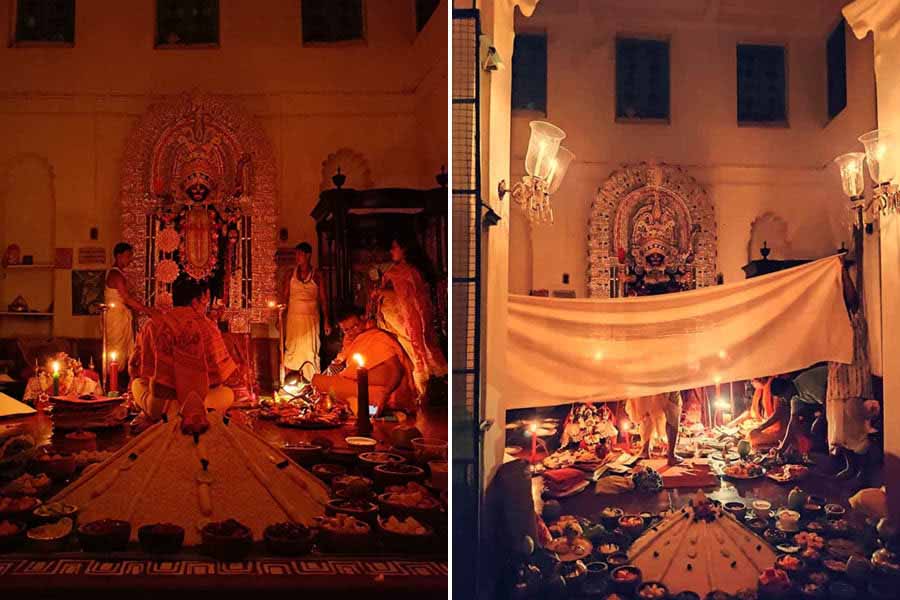
(Left) Kali ‘pujo’ starts shortly after completion of rituals around 11pm. All electric lights are turned off. (Right) The ‘thakur dalan’ has two paired glass lamps (phanush) that has candles lit inside them
Kali Puja starts shortly after completion of these rituals around 11pm. When the puja begins, all the electric lights in the house are turned off. Candles and lamps are lit all over the premises. The thakur dalan has two paired glass lamps (phanush), which has candles lit inside them. Earlier, there were many such lamps in the house. 108 brass lamps are lit and kept on hay spread on the stairs of thakur dalan.
Earlier, there was the ritual of sacrificing a goat in the house. In 1920, Sheffield Steel owner John Yeats visited the residence of the Haldar family during Durga Puja. He was so impressed by the puja that he drew the design of the khnara (sacrificial sword) used for animal sacrifice while returning home from Calcutta. Within a few days, he sent a beautiful khnara made of steel from his country. But it was so heavy that people gasped while sacrificing with it. So Yeats sent across a lighter version. Rakhaldas decided to conduct the animal sacrifice of Kali Puja also using this khnara. The animal sacrifice continued for over 20 years and finally stopped after Rakhaldas had a change of heart after the terrible riot and bloodshed of 1946 in Calcutta. He did not want any more bloodshed in his house.
Since then, sugarcane, rice gourd and cucumber are sacrificed during puja with that khnara. A torch with flames (mashaal) is lit during the sacrifice.
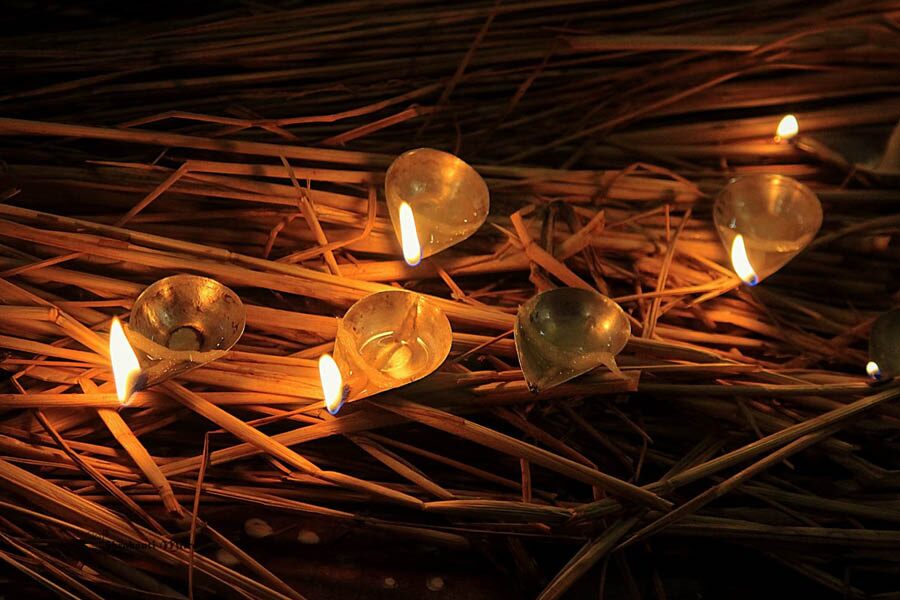
Some of the 108 brass lamps that are lit and kept on hay spread on the stairs of the ‘thakur dalan’ Bowbazar Haldar Family
Kali Puja is conducted at the Haldar family residence following Shakta rituals. Although there is no animal sacrifice, household members, who do not fast during the puja, consume non-vegetarian food during the puja.
The baron dala or the offering tray for the goddess comprises a bunch of kathali bananas, liquid sindur (vermilion) in stone pots, brass lamps, dried paddy, barley, white mustard, til, mashkolai, white and red threads, mirror, pancha sashya ( five grains), two sets of pancha ratna, four alta pata, ghee, eight suparis and eight haritaki, four bahera or beleric, iron bangle with a wooden handle, eight cowries, abatha, Aguru incense sticks, turmeric, Jabakusum oil, unprocessed sugar, curd, kharimati, Ganga mati, sraba-ousadhi and maha-aushodhi (medicinal items) and chamor (to fan the Goddess), suto latai (to keep threads) and a small conch. Small square asan made of silver and silver rings are also used during puja.
The deities are offered the following clothes — four saris, three dhotis, three plain cloth (thaan) and three gamcha. The liquor offered to the goddess alias karon is prepared by the priest on an indigenous manner.
108 doob grass along with 100 unbroken grains of rice are wrapped inside an aaltapata are tied with a red thread to make the special arghya (offering to the goddess) at the Haldar residence, which is an important part of the household Kali Puja. The arghya is not shared with anyone.
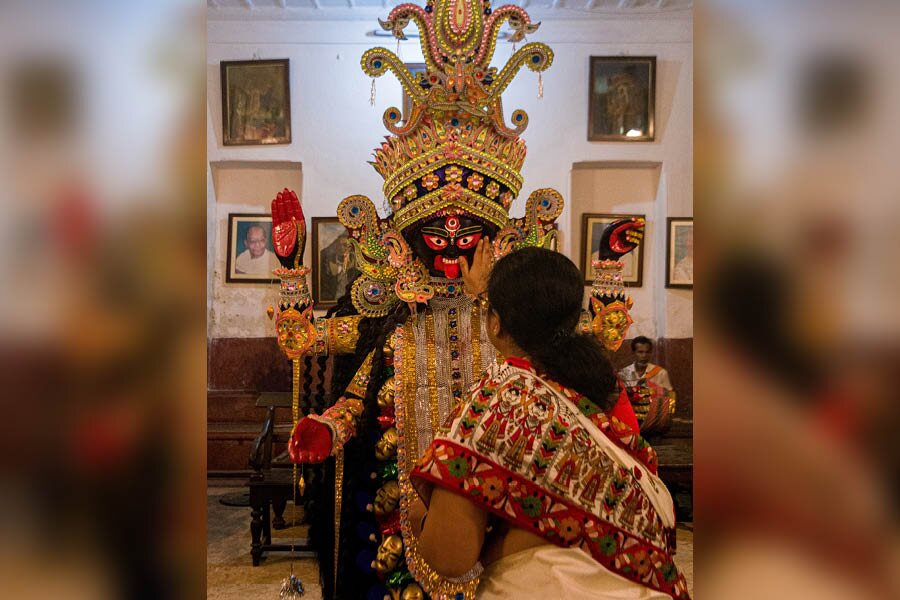
A woman performs ‘baron’ rituals before immersion Bowbazar Haldar Family
Among food offerings, unprocessed sugar is an important element. Earlier, it used to be served in a heap which went up to the height of the tongue of the goddess. That sugar is still considered as a significant offering but is not served in that big quantity. Rice naibedya is also offered in a large quantity. Apart from the sugar offering, the goddess is given an offering of luchi (deep-fried flatbread made of maida), garnished with various fruits and sweets like manahora, rasakada, chandrapuli, naru and kheer.
After womenfolk finish Sindoor Khela rituals following baron rituals offering Jharkhili paan (betel leaf) to the goddess before immersion, the ritual of Kankanjali is done offering paan, supari and uncooked rice. There was the ritual of immersion in boat in earlier days with lit mashaals, which has stopped since long.
The members of the Haldar family household feel depressed after immersion of the Kali idol in the Hooghly, which is why no food is cooked after the immersion.

